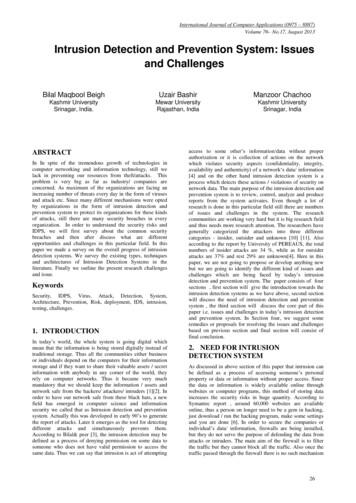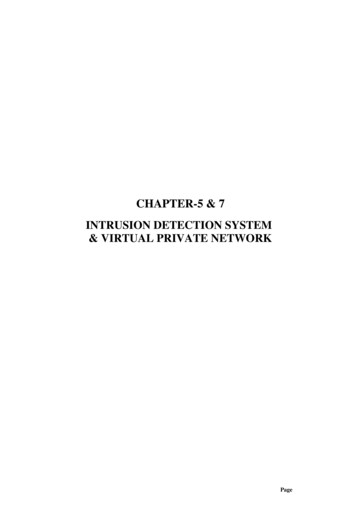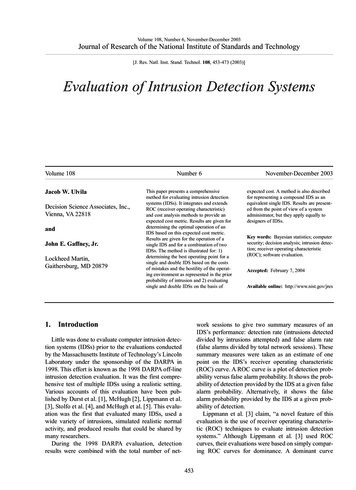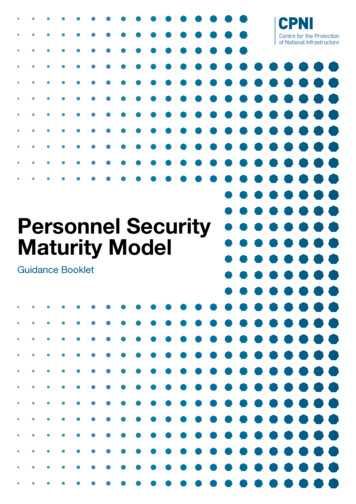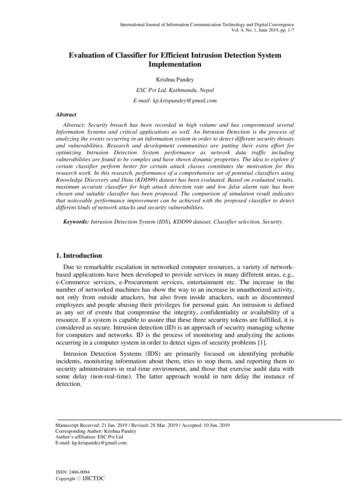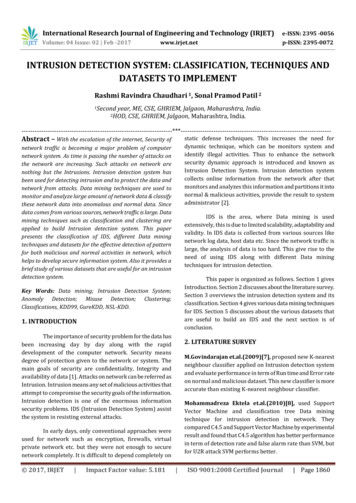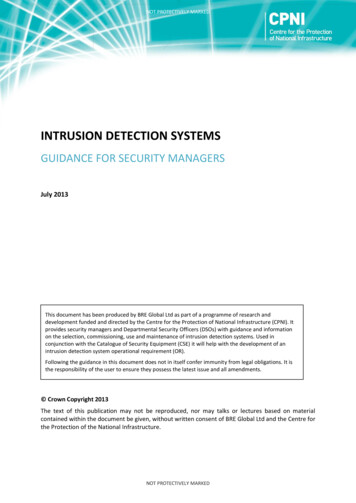
Transcription
NOT PROTECTIVELY MARKEDINTRUSION DETECTION SYSTEMSGUIDANCE FOR SECURITY MANAGERSJuly 2013This document has been produced by BRE Global Ltd as part of a programme of research anddevelopment funded and directed by the Centre for the Protection of National Infrastructure (CPNI). Itprovides security managers and Departmental Security Officers (DSOs) with guidance and informationon the selection, commissioning, use and maintenance of intrusion detection systems. Used inconjunction with the Catalogue of Security Equipment (CSE) it will help with the development of anintrusion detection system operational requirement (OR).Following the guidance in this document does not in itself confer immunity from legal obligations. It isthe responsibility of the user to ensure they possess the latest issue and all amendments. Crown Copyright 2013The text of this publication may not be reproduced, nor may talks or lectures based on materialcontained within the document be given, without written consent of BRE Global Ltd and the Centre forthe Protection of the National Infrastructure.NOT PROTECTIVELY MARKED
NOT PROTECTIVELY MARKEDContentsIntroduction .4Abbreviations.5Theory and concepts of IDS .6Basic principles .6Reliable operation .7Defence in Depth .7CPNI Grading Structure .8Standards and Regulations .9Standards .9Commercial alarm systems. 10Introduction of European Standards within the UK . 10Component grading . 11Regulations for components . 11Codes of Practice for alarm confirmation . 12Intrusion Detection - Components . 15Control and indicating equipment . 15Control panel . 15Inputs/outputs . 17Configuration . 17Event recording . 17Remote access . 18User interface. 18Power supplies . 19Detectors. 22Warning devices . 23Alarm transmission systems . 23Intrusion Detection - Systems . 27Commissioning . 27System handover . 28Documentation and records . 29Documentation . 29Records . 30NOT PROTECTIVELY MARKED2
NOT PROTECTIVELY MARKEDMaintenance. 30Confidence checking . 32Control and indicating equipment . 32Detectors . 33Motion detectors . 32Glass break detectors . 35Vibration/shock detectors. 36Protective switches . 36Active infrared detectors . 37Warning devices . 37Alarm transmission equipment . 37Wiring and interconnections . 37System operation . 38Setting the IDS . 39Un-setting the IDS . 39Alarm handling . 40Management of false alarms . 40Operator training . 41Performance . 42Availability. 43Integration. 43Siting IDS components . 45Control and indicating equipment & power supplies . 45Ancillary control equipment (ACE) . 45Detectors . 46Alarm transmission equipment. 46Warning devices. 46Wiring and interconnections . 47Environmental Considerations . 49Definitions51References 54Standards and references . 55Further reading . 57ANNEX A Detection technologies . 59Motion detection . 59Glass break detectors. 81Vibration and shock detectors . 86Protective switches . 91Active infrared detectors . 96ANNEX B Warning device types . 100Audible warning devices . 100Visible warning devices . 102NOT PROTECTIVELY MARKED3
NOT PROTECTIVELY MARKEDIntroductionThe purpose of this document is to inform security managers, Departmental Security Officers (DSOs)and those responsible for determining the operational requirements of intrusion detection systems(IDS), and those who ensure that performance of the systems is maintained.The guidance given relates to electronic IDS intended for indoor use. It includes good practice adviceon installation, commissioning, operation and the maintenance necessary to keep the IDS systemoperating effectively and reliably. The concepts behind intrusion detection, the technologies used andhow they should be applied are explained.Key information is marked by the following symbols:'Must read' informationCautionary NoteUseful information or tipThroughout this document reference is made to security managers but also includes DSOs and otherpersons responsible for the correct operation of intrusion detection systems.Security managers new to the role should find the guidance a helpful starting point, whilst those moreexperienced will have a useful source of reference.Before attempting to write a performance specification for a new intrusion detection system, it isimportant to ensure that a comprehensive operational requirement (OR) has been produced toprovide the necessary details about the requirement.This document does not include guidance on writing operational requirements, however advice can befound in CPNI’s Guide to Producing Operational Requirements for Security Measures1.The information in Annex A and B is provided for those interested in knowing more about detectiontechnology and warning device types.NOT PROTECTIVELY MARKED4
NOT PROTECTIVELY URCTSABSCBSNESPTSSAIBTCP/IPUDPAncillary Control EquipmentActive InfraredAlarm Receiving CentreAlarm Transmission EquipmentAlarm Transmission PathAlarm Transmission SystemBritish TelecomBinary Unit SystemClosed Circuit TelevisionControl and Indicating EquipmentCrime Prevention through Environmental DesignComma Separated VariableDepartmental Security OfficerElectromagnetic CompatibilityEuropean NormGeneral Packet Radio ServicesGlobal System for Mobile CommunicationsHold-up deviceIntrusion and Hold-up Systems (As used by the European EN standards)Intrusion Detection SystemLight Emitting DiodeLow Voltage DirectiveNational Security InspectorateOperational RequirementPublished Document (a document published by BSI which is not a standard)Passive InfraredPower Supply UnitReceiving Centre TransceiverSelf-actuating BellSelf-contained BellSite Network EquipmentSupervised Premises TransceiverSecurity Systems and Alarm Inspections BoardTransmission Control Protocol/Internet ProtocolUser Datagram ProtocolNOT PROTECTIVELY MARKED5
NOT PROTECTIVELY MARKEDTheory and concepts of Intrusion Detection SystemsBasic principlesThe primary purpose of an intrusion detection system is to detect and signal the presence of anintruder or an intrusion attempt into a secured area. A secured area can be a selected room, an entirebuilding, or group of buildings. The term 'supervised area/premises' is used in this guide to describethe protected area or building.In principle, a basic intruder detection system will comprise a means to interface with the systemuser(s), e.g. a keypad with alpha-numeric display permitting authorised persons to interact with thesystem by setting and un-setting the IDS and viewing status indications.Control electronics connected to the user interface will perform the set and unset functions and willhave provision to receive inputs from detection devices distributed throughout the supervisedarea/premises in strategically located positions. The action of signalling the intrusion event (or to usethe correct terminology, ‘to notify’) is also made by the control electronics.In practice the component parts of an IDS are normally housed in discrete enclosures, although intheory other configurations are possible and IDS of the future may be integrated into other types ofequipment, such as building control modules, light fittings and other fixtures. However, for theforeseeable future, there will continue to be a discrete control panel housing the control/processingelectronics and, usually, a power supply.The system will have one or more detectors and at least one means of raising the alarm. This may bean audible siren, visible indicator (e.g. a strobe light) or a transceiver capable of sending an electronicsignal or message to a monitoring centre or guarding force located either at the supervised premisesor on another site remote from the supervised premises.Figure 1: Schematic showing the componentsof a typical intrusion detection systemNOT PROTECTIVELY MARKED6
NOT PROTECTIVELY MARKEDReliable operationThe most important aspect of any intruder detection system is its reliability. A significant step towardsachieving a reliable system is selecting equipment and components which are compatible with theservice environment. Equally important is to position and configure the equipment correctly toprovide the desired performance. Motion detectors capable of detecting minute emissions of heatenergy radiating from the body of an intruder are also expected to tolerate the climatic changes thatmay occur between the temperature extremes of the day and the night without creating a false alarm.Technology can make such demanding requirements possible, but good installation practice must befollowed to ensure an acceptable level of reliability is achieved in service.An acceptable balance between false alarm immunity and the rapid detection of an intruder must befound. If a suitable balance cannot be achieved, the OR may need to be revised. Where conflicts ofopinion exist regarding the most effective compromise, it is recommended that performance bedemonstrated before any significant commitment is made.The intrusion detection system will normally be designed to provide the earliest possible warning ofan intrusion attempt. Securing a premises or area against unauthorised entry requires physicalprotection, using suitably robust fences, barriers, walls, and doors etc. Physical security serves toprevent or at least delay entry. Electronic intrusion detection systems on the other hand are intendedto provide the means to detect and signal unauthorised entry attempts in sufficient time to permit theresponse force to arrive before the physical barriers are breached, or where only limited access to theprotected area has been achieved.Defence in DepthIt is good practice to implement protection in layers. This approach is often referred to as an ‘onionskin’, requiring the penetration of multiple protective measures before assets of any significance canbe reached. The concept of layering is applicable to both the implementation of physical securitymeasures and the intrusion detection system components. Indeed it should be considered an essentialfeature of security protection because individual components will have their specific strengths andweaknesses but when used together to form a complete system the weaknesses take on lesssignificance.The application of security measures must be tailored to the needs of the facility to be secured. Thesecurity approach will be influenced by the type of facility, the nature of the assets to be protected,previous experience and the perceived threats and vulnerabilities. These parameters must beidentified by the completion of an Operational Requirement (OR) which provides a statement of theoverall security need. It is from the OR that the basic criteria and specification for the intrusiondetection system can be determined.The type of intrusion detection system installed and the technologies deployed depends upon thelevel of security required, the environment in which the intrusion detection components are to beused and the activities undertaken within the secured area(s). The aim is to achieve a high probabilityof detection of intruders, with a minimum of false alarms and as far as possible, the least disruption tolegitimate users.NOT PROTECTIVELY MARKED7
NOT PROTECTIVELY MARKEDCPNI Grading structureTo guide security managers in their choice and recommendations, CPNI grades both systems andcomponents. Two methods of grading IDS are in place and their use is dependent upon the nature ofthe asset and the perceived threat.The CPNI Class Rating system is to be used to protect protectively marked material againstundetected compromise.The CPNI Protection Level system is to be used to protect all assets against theft and damage.The table below specifies the intent of the attack or threat to be countered in relation to the type ofasset being protected and designates which CPNI grading system should be applied.Attack PurposeTable 1: CPNI grading matrixAssetTypeUndetectedCompromiseAssetofAsset TheftAsset assProtectionProtectionThe choice of a particular Protection Level for protecting assets from theft and/or damage will bebased on the Operational Requirement approach. The selection of the appropriate CPNI Class Ratingfor products or systems will be based on a risk assessment as described in the security PolicyFramework, (SPF)2 using security Assessment for protectively Marked Assets (SAPMA)3 in conjunctionwith an OR-based methodology.Selection of the appropriate CPNI Protection Level for products or systems will be made following theproduction of a detailed Operational Requirement (Level 1 and Level 2). Consult CPNI for advice on theappropriate Protection Level for the elements to be deployed.Product and system requirements to meet the specific CPNI grading are contained within publishedCPNI Standards. Consideration is given to the likely knowledge and skills of an attacker, the availabilityof tools or equipment the attacker may employ together with the likelihood of an attack leaving visibleevidence. A view is also taken regarding false alarms which cause the system to be discredited. It isrecognised that for installed systems, factors which influence this include the provision of alarmconfirmation (e.g. CCTV) together with the motivation of the guard force.Products successfully demonstrating compliance against these standards are listed in the Catalogue ofSecurity Equipment (CSE)4. Selection of products from the CSE should be supported by a performancespecification appropriate to the specific application/installation.NOT PROTECTIVELY MARKED8
NOT PROTECTIVELY MARKEDStandards and regulationsStandardsThe former British Standards BS 47375, BS 70426 and BS 67997 which were used to govern thespecification, installation and maintenance of IDS in the UK were withdrawn on 1 October 2005 infavour of a common set of European 'EN' standards (i.e. European norms). These have now becomethe accepted minimum requirement for IDS across Europe. The implementation in the UK was definedin PD 66628, which also included elements omitted from the European standards such as maintenancerequirements.The main set of European norms applicable to IDS is the EN 50131 series, which has been adoptedby British Standards and re-labelled BS EN 5013110.BS EN 50131 is one of a family of standards which were created to make it easier for securityequipment manufacturers to sell products in all EU countries and permit security installationcompanies and engineers to work across borders in those countries. The standards also provide morevisibility and understanding for customers in order to judge the quality of products sourced fromanywhere within the European Union.The standards applicable to electronic security equipment are:BS EN 50130 - Environmental and EMC requirementsBS EN 50131 - Intrusion systemsBS EN 50132 - CCTVBS EN 50133 - Access ControlBS EN 50134 - Social AlarmsBS EN 50135 - Hold-Up AlarmsBS EN 50136 - Alarm Transmission SystemsBS EN 50137 - Combined or Integrated SystemsBS EN 50131 comprises:BS EN 50131-1 - General RequirementsBS EN 50131-2 - Intrusion DetectorsBS EN 50131-3 - Control and Indicating EquipmentBS EN 50131-4 - Warning DevicesBS EN 50131-5 - InterconnectionsBS EN 50131-6 - Power SuppliesBS EN 50131-7 - Application GuidelinesBS EN 50131-8 - Security Fog devicesBS EN 50131-9 - Alarm verification - Methods and principlesFull titles and references of the sub parts can be found in the References section of this document.In addition to the standards listed, there is a legal obligation for equipment manufacturers to ensuretheir products comply with the electrical safety and electromagnetic compatibility requirements of theapplicable EU Directives, see Regulations for Components.NOT PROTECTIVELY MARKED9
NOT PROTECTIVELY MARKEDCommercial alarm systemsBS EN 50131-110 sets out four classifications of environmental performance levels (i.e. Class l to ClassIV). These are representative of conditions ranging from benign indoor to exposed outdoor locations.Refer to Environmental considerations for further guidance.To avoid confusion, it is strongly recommended that the OR clearly distinguishes betweenthe classification of environmental performance of BS EN 50131-110 and the Class Ratings 1to 4 of the CPNI grading system.The BS EN 50131-110 standard also defines four security grades (i.e. Grade 1 to Grade 4):Grade 1: Low risk - an intruder or robber is expected to have little knowledge of I&HAS and berestricted to a limited range of easily available tools.Grade 2: Low to medium risk - an intruder or robber is expected to have a limited knowledge ofI&HAS and the use of a general range of tools and portable instruments (e.g. a multi-meter).Note: The PD 6662 scheme in the UK also permits Grade 2 'X', a variation of Grade 2 where the IDS hasaudible warning devices but is not monitored by an ATS.Grade 3: Medium to high risk - an intruder or robber is expected to be conversant with I&HAS andhave a comprehensive range of tools and portable electronic equipment.Grade 4: High risk - to be used when security takes precedence over all other factors. An intruder orrobber is expected to have the ability or resource to plan an intrusion or robbery in detail and have afull range of equipment including means to substitute components in an I&HAS.Typically there are only two grades commonly adopted in the UK: Grade 2X for 'bells only' systems(usually implemented for domestic application), and Grade 3 for remotely monitored systems (theminimum insurance standard for high value domestic risk and commercial systems).Introduction of European Standards within the UKTo help align BS EN 50131, Part 1- System requirements10 with the practices of the UK intruder alarmindustry, the European requirements are supplemented by PD 66628. Both documents are used inconjunction with the application guidelines of DD CLC/TC 50131-79.Companies accredited under installer schemes operated by the UK inspectorates, such as NSI andSSAIB, will have their installations inspected for compliance with BS EN 50131-110 and PD 66628 orwhere appropriate, the CPNI gradings.It is not necessary for the security manager to obtain all parts of the BS EN 50131 series ofstandards. It is recommended that BS EN 50131-1 - System Requirements10, DD CLC/TS 50131-79 - Application guidelines, PD 66628, BS 824313, BS 847315 and DD 26314 arepurchased. These documents form the basis of the requirements for IDS installations withinthe UK.Supervised premises transceivers shall as a minimum, conform to the requirements of the appropriateparts of BS EN 50136 - Alarm Transmission Systems20 as specified by BS EN 50131-110.NOT PROTECTIVELY MARKED10
NOT PROTECTIVELY MARKEDComponent gradingThe security grading and environmental classification systems of EN50131 should not be confusedwith the CPNI Protection Levels and Class Ratings, they are different. However, the EN and CPNIsystems complement one another; for example, the requirements for the CPNI Protection Levels buildupon the performance requirements associated with EN security grade 3 and in some instances, ENsecurity grade 4.Compliance with the relevant EN security grade 3 standards must be demonstrated as a prerequisitefor listing IDS components in the Catalogue of Security Equipment. Intrusion equipment that has beenself-certified by the equipment manufacturer or supplier is not accepted.IDS components required for use with applications designated asrequiring CPNI Protection Level ENHANCED or HIGH and all CPNI ClassRatings shall also have been tested to, and have met the requirementsof the applicable CPNI IDS standards. See page 56.IDS components for use with applications designated as requiringProtection Level BASE shall as a minimum, require evidence ofcompliance with the relevant EN security grade 3 requirements.Acceptable evidence shall be an approval certificate or test reportfrom an accredited certification body/test laboratory that isindependent from the equipment manufacturer/supplier.Regulations for componentsFigure 2: Example CPNI - IDS StandardUnlike fire detection equipment, the performance standards and requirements associated with IDS arenot mandated, meaning that manufacturers of IDS equipment do not need to demonstratecompliance with the EN 50131 standards in order to CE mark their products.The exceptions are the electrical safety requirements and electromagnetic compatibility of the LVD 11and EMC12 Directives respectively. There is a legal obligation for IDS manufacturers to confirm that therequirements prescribed by these directives have been fulfilled; applying the CE mark on the productis a declaration that they have.The manufacturer must produce a technical construction file for each product in which justification ismade describing how compliance is achieved. Alternatively the manufacturer may choose to have theproducts independently tested to confirm compliance.It should be noted that compliance with the LVD11 and EMC12 Directives is applicable to the IDScomponents as they were placed on to the market. The fitting of other IDS devices/modules into theenclosures of compliant equipment may invalidate that compliance. An example could be the fitting ofa supervised premises transceiver (SPT) into a control panel enclosure - unless specific laboratory testshave been conducted to verify continued compliance with that particular equipment combination.Unfortunately, if no such evidence exists there is little that the security manager can do other than tobe aware.Only components carrying a CE mark should be fitted to intruder detection systems covered by thisguidance.NOT PROTECTIVELY MARKED11
NOT PROTECTIVELY MARKEDCodes of Practice for alarm confirmationIn addition to the standards and regulations applicable to IDS, the UK has some Codes of Practicewhich may be of interest to the security manager. Reference to these is made here for informationonly.If a response is required from a local police force, CNI sites should consult their CPNI adviser to check13whether a local agreement exists which may override the requirements identified in BS 8243 .Codes of Practice take the form of guidance and recommendations; they are not intended to be usedas specifications. Two documents of particular relevance are:BS 824313 - Installation and configuration of intruder and hold-up alarm systems designed togenerate confirmed alarm conditions – Code of practiceBS 847315 - Intruder and ho
Theory and concepts of Intrusion Detection Systems Basic principles The primary purpose of an intrusion detection system is to detect and signal the presence of an intruder or an intrusion attempt into a secured area. A secured area can be a selected room, an entire building, or group of buildings.

